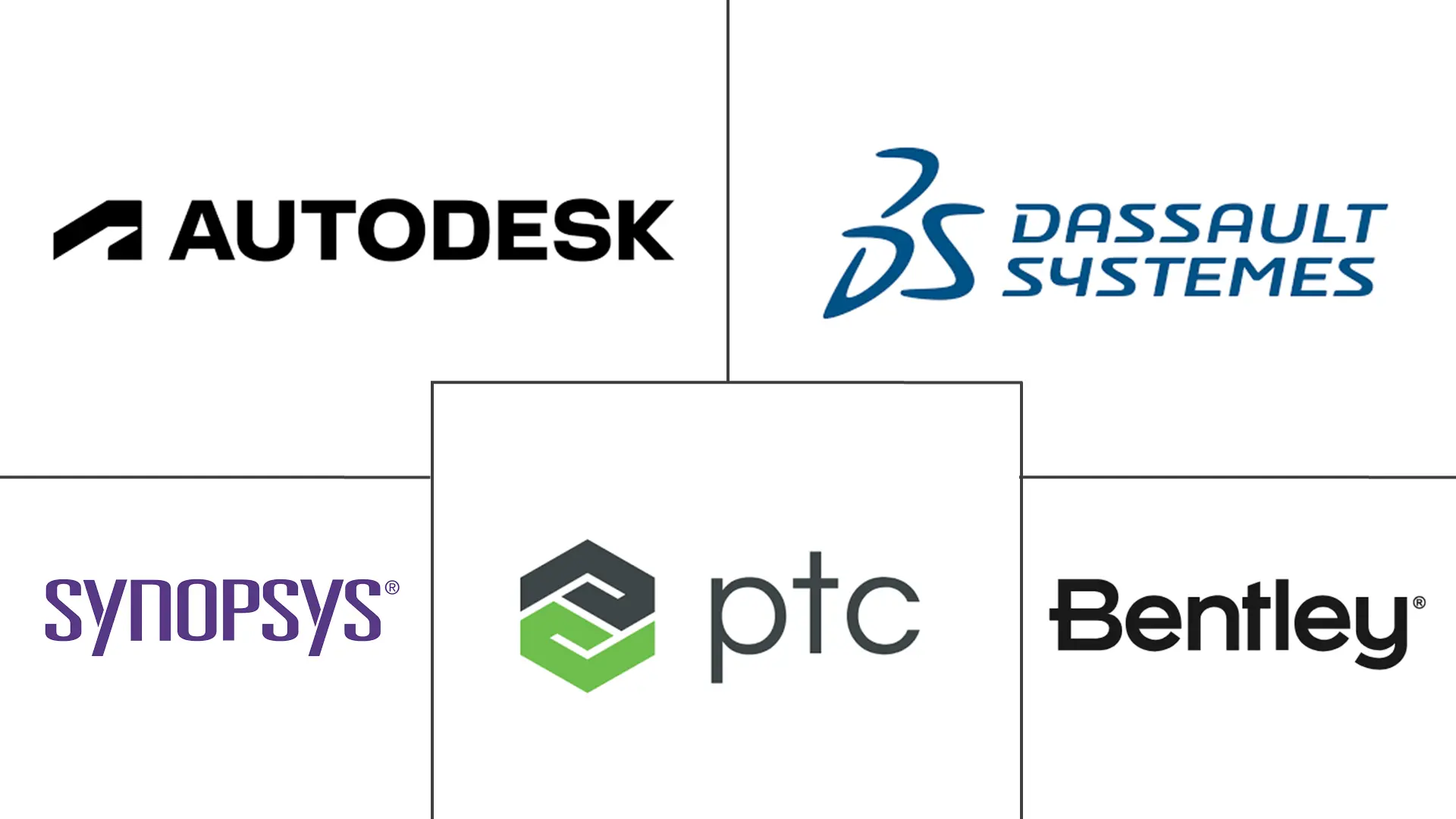Generative Design Market Size and Share
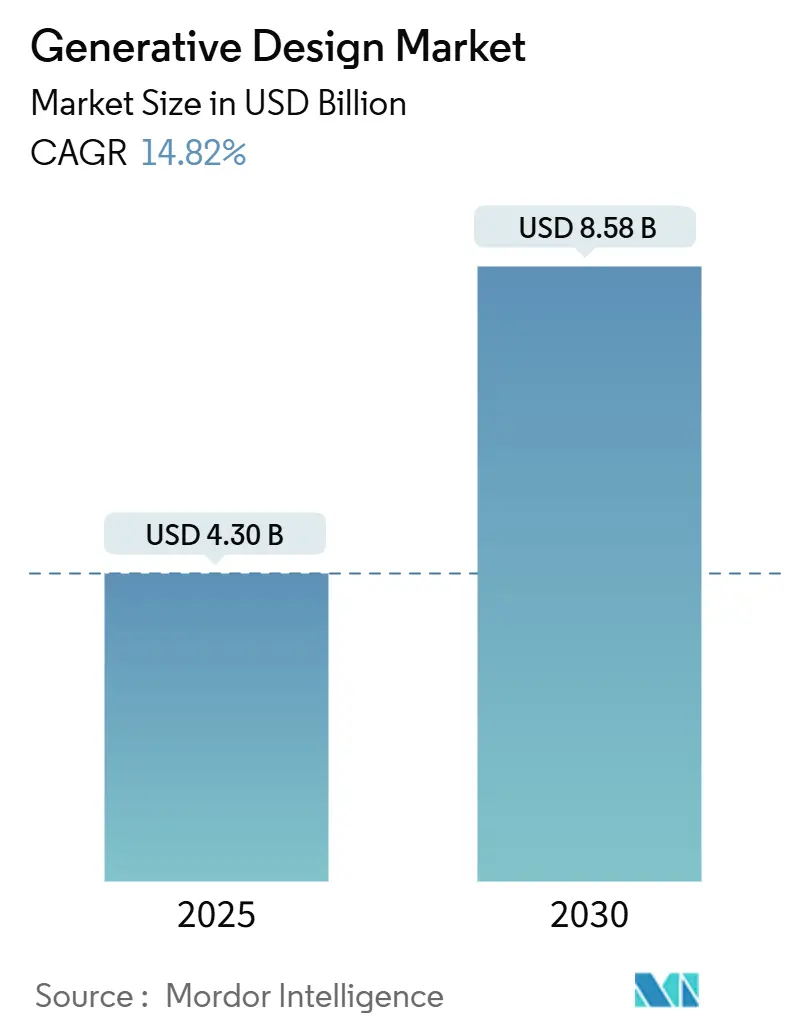
Generative Design Market Analysis by Mordor Intelligence
The Generative Design Market size is estimated at USD 4.30 billion in 2025, and is expected to reach USD 8.58 billion by 2030, at a CAGR of 14.82% during the forecast period (2025-2030). The expansion is shaped by AI-first design workflows that allow engineers to optimize weight, cost, and performance in a single computational pass, replacing the traditional design-then-iterate routine. Cloud accessibility lowers entry barriers for small manufacturers, while increasingly stringent sustainability mandates encourage material-efficient products that cut lifecycle emissions. Recent consolidation, most notably Siemens’ USD 10.6 billion acquisition of Altair, signals that buyers now regard generative design as a core competitive capability rather than a specialized engineering add-on [1]“Siemens to Acquire Altair Engineering,” Siemens Press Release, siemens.com. Competitive intensity rises as established CAD vendors embed AI algorithms and AI-native firms offer cloud-first platforms, resulting in a moderate but tightening market structure.
Key Report Takeaways
- By component, software led with 58.34% of the generative design market share in 2024; the services segment is projected to advance at a 15.12% CAGR to 2030.
- By deployment, on-premise solutions accounted for 62.45% of the generative design market size in 2024, while cloud deployment is forecast to expand at 15.23% CAGR through 2030.
- By technology, topology optimization dominated with a 36.45% share in 2024; AI-driven multi-objective optimization is poised to grow at a 16.34% CAGR to 2030.
- By end-user industry, automotive commanded 28.67% share of the generative design market in 2024; medical devices represent the fastest-growing application with a 15.87% CAGR outlook.
- By geography, North America retained a 38.50% share in 2024, whereas the Asia Pacific is projected to climb at a 16.92% CAGR through 2030.
Global Generative Design Market Trends and Insights
Drivers Impact Analysis
| Driver | (~) % Impact on CAGR Forecast | Geographic Relevance | Impact Timeline |
|---|---|---|---|
| Lightweighting needs in automotive and aerospace | +3.2% | North America, Europe | Medium term (2–4 years) |
| Cloud‐based HPC access for SMEs | +2.8% | Asia Pacific, Global | Short term (≤ 2 years) |
| Integration with additive manufacturing workflows | +2.5% | North America, Europe, Asia Pacific | Medium term (2–4 years) |
| Sustainability-driven carbon-footprint optimization | +2.1% | Europe, North America | Long term (≥ 4 years) |
| Real-time digital-twin embedded generative loops | +1.9% | Global | Long term (≥ 4 years) |
| Generative design adoption in circular-economy business models | +1.7% | Europe, Global | Long term (≥ 4 years) |
| Source: Mordor Intelligence | |||
Light weighting imperatives drive automotive and aerospace adoption
Regulatory fuel-economy targets and electric-vehicle range expectations leave automakers little choice but to strip mass without sacrificing crash performance. A General Motors program that applied generative algorithms to a seat bracket achieved a 40% weight cut while meeting all safety criteria, illustrating how AI simultaneously balances multi-variable constraints that previously required many manual iterations [2]“Generative Design Applications in Automotive Manufacturing,” General Motors Innovation Report, gm.com. Airlines pursue the same logic at fleet scale; Airbus reported a 45% lighter cabin-partition bracket developed through topology optimization, resulting in fuel savings that amplify across thousands of flight hours. North America and Europe feel the greatest urgency because emissions standards tighten each year, translating weight into direct compliance and cost benefits. Suppliers that master rapid AI-led redesign win new platform contracts, accelerating diffusion across the value chain. As lightweight benchmarks rise, traditional design approaches struggle to keep pace, reinforcing demand for AI-generated geometries throughout the decade.
Cloud HPC democratizes advanced design capabilities for SMEs
Small manufacturers once excluded by six-figure hardware investments now subscribe to cloud high-performance computing for as little as USD 1,000 per month, gaining the same compute scale Fortune 500 peers enjoy. The subscription model reshapes adoption economics across the Asia Pacific, where many contract manufacturers operate on thin margins yet serve global OEMs. Specialized cloud instances deliver 10× faster solve times for generative solvers than general-purpose servers, shortening iteration cycles from days to hours. Engineering teams shift workloads elastically, paying only for peak computation during design sprints, which makes business cases straightforward even for single-product firms. Providers bundle hardened security frameworks that ease lingering IP concerns, nudging regulated industries toward hybrid models that blend on-premise storage and cloud compute bursts. The outcome is a wider funnel of users entering the generative design market, boosting license growth on both software and services lines.
Additive manufacturing integration creates seamless design-to-production workflows
Generative design algorithms now bake in manufacturing constraints for 3D printing, ensuring that every geometry the AI suggests can be produced without re-engineering. Desktop Metal’s Live Parts platform automatically validates printability, collapsing a week-long prototype loop to a single afternoon [3]“Live Parts Platform for Additive Manufacturing,” Desktop Metal Product Documentation, desktopmetal.com. Medical device firms exploit this feature for patient-specific implants, where complex lattice structures offer both weight reduction and osseointegration benefits. Aerospace suppliers adopt similar workflows for bracketry, saving tooling costs by skipping conventional subtractive steps. Material-aware algorithms further refine internal cavities to maximize strength-to-weight ratios, cutting powder consumption and print time. As additive machines scale and build volumes, entire sub-assemblies merge into monolithic printed parts, multiplying the design freedom unlocked by generative software.
Sustainability mandates accelerate carbon-footprint optimization
European carbon-border adjustment regulations and corporate net-zero pledges add environmental metrics to the design scorecard. Decathlon’s bicycle-frame redesign cut material use by 30% while boosting stiffness, letting the brand publish a verified lifecycle-emissions reduction on product labels [4]“Sustainable Product Design Through AI Optimization,” Decathlon Sustainability Report, decathlon.com. Similar initiatives spread to packaging, furniture, and consumer electronics, where lightweight parts translate into lower shipping emissions and less virgin material. Design teams embed lifecycle-assessment modules alongside structural solvers, allowing carbon intensity to act as a hard constraint rather than a nice-to-have. Because penalty schemes and consumer scrutiny both escalate past 2026, firms that optimize early lock-in cost and reputation advantages. Material suppliers respond by feeding environmental data sheets into generative engines, tightening the feedback loop between design and sustainability goals.
Restraints Impact Analysis
| Restraint | (~) % Impact on CAGR Forecast | Geographic Relevance | Impact Timeline |
|---|---|---|---|
| High software cost and steep learning curve | -2.3% | Global, Emerging Markets | Short term (≤ 2 years) |
| Data-interoperability gaps across CAD/CAE suites | -1.8% | Global | Medium term (2–4 years) |
| IP ownership ambiguity for AI-generated designs | -1.5% | Global | Long term (≥ 4 years) |
| Regulatory-approval delays for safety-critical parts | -1.2% | Global | Medium term (2–4 years) |
| Source: Mordor Intelligence | |||
Software cost and learning curve barriers limit SME adoption
Annual license bundles for enterprise-grade generative platforms range between USD 50,000 and USD 200,000 per seat, an order of magnitude above mainstream CAD tools and out of reach for many small firms. The expense grows when integration connectors, training sessions, and workflow consulting are factored in. Even when budgets stretch, new users need 6-12 months to become proficient, limiting short-term productivity gains. In emerging economies where engineering salaries are lower, software list prices remain pegged to global rates, making the cost-to-salary ratio especially painful. Vendors respond with consumption-based licensing, but adoption still lags where capital budgets are tight and payback horizons short. Unless pricing models evolve further, a portion of the manufacturing base will postpone entry, muting near-term expansion of the generative design market.
Data-interoperability gaps fragment design workflows
Generative outputs often move through simulation, CAM, and PLM systems that were not built for AI-native geometry, leading to translation errors and lost metadata. Engineers must fix tessellation glitches or manually recreate parametric features, eroding the efficiency benefits that justified the investment. Heterogeneous IT stacks exacerbate the problem because each division may run different CAD kernels. Downstream manufacturing planning tools sometimes strip algorithm-generated lattice information, forcing redundant iterations. Although STEP and other neutral formats evolve, real-time synchronization between cloud solvers and legacy desktop software remains limited. Mid-term, vendors race to open APIs and lightweight viewers, but until seamless pathways emerge, productivity drag will persist.
Segment Analysis
By Component: Services accelerate as implementation expertise becomes critical
The services line of the generative design market recorded the fastest growth trajectory, rising toward a 15.12% CAGR, while software retained a 2024 revenue lead of 58.34%. Consulting teams help manufacturers stitch AI solvers into PLM systems, configure data pipelines, and customize optimization objectives that reflect industry codes. As more firms move beyond proofs of concept, integration complexity and change-management needs rise, propelling service revenues. Top providers bundle workshops, pilot projects, and proprietary training curricula, capturing annuity-like fees that outpace one-off license sales.
Software still anchors the value chain because core algorithms remain proprietary and command premium annual subscriptions in the USD 10,000-USD 50,000 range. Vendors continuously add modules, structural, thermal, fatigue, and carbon calculi, to justify price escalations and defend margins. Ecosystem lock-in from file formats and data analytics dashboards keeps churn low, but customers increasingly negotiate bundled deals that mix software and advisory projects. Successful suppliers differentiate by offering rapid-start templates for verticals such as aerospace seat components or orthopedic implants, shortening time to ROI and protecting their software positions even as service partners bloom.
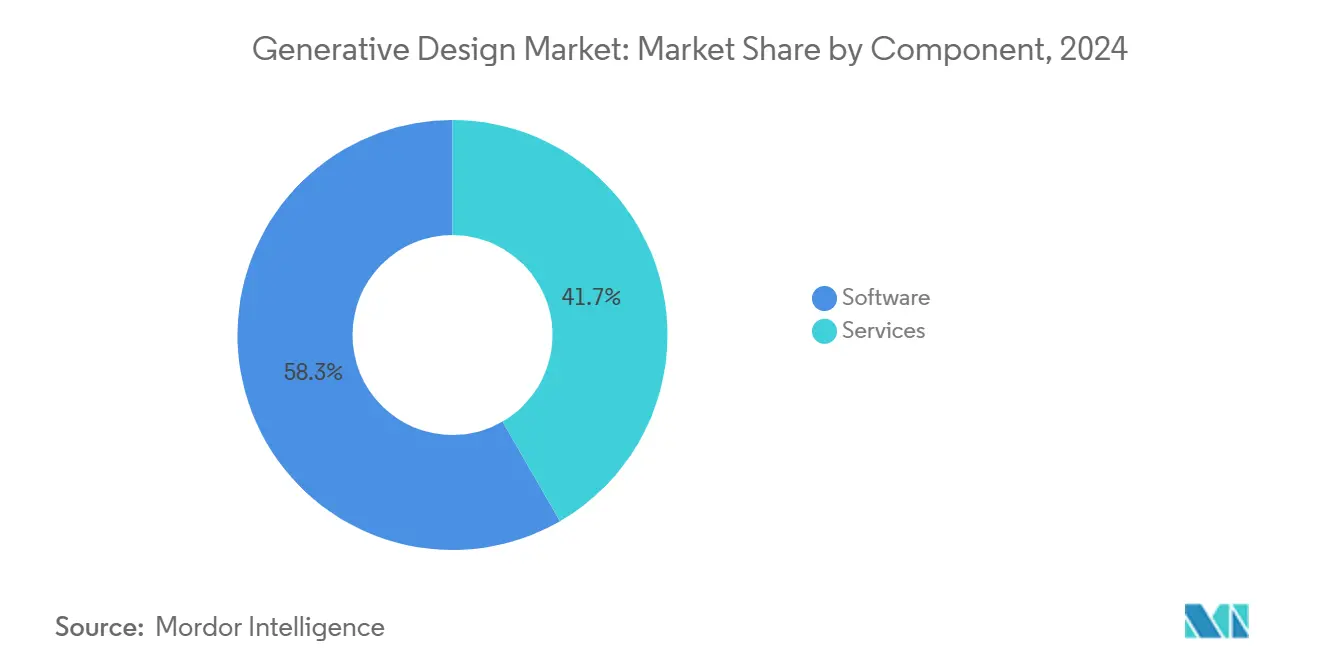
By Deployment: Cloud adoption accelerates despite on-premise dominance
On-premise installations captured 62.45% of the generative design market share in 2024, reflecting strict IP-protection norms in aerospace and defense. Those sectors prioritize perimeter-controlled data centers and direct GPU clusters to guard proprietary geometries. However, cloud subscribership is expanding at a 15.23% CAGR as SMEs and less-classified projects prize elastic compute over air-gapped control. Early adopters run sensitivity analyses in the cloud while keeping master models in local vaults, a hybrid pattern that balances risk and speed.
Cloud providers sharpen their pitch with purpose-built HPC instances that offer near-linear scaling across thousands of cores, cutting optimization runtimes from eight hours to 40 minutes on complex assemblies. Encryption at rest and zero-trust access frameworks now meet many compliance audits, eroding objections from cautious industries. Subscription licensing further sweetens the deal because costs align with actual compute cycles rather than static capacity. As these economies converge with maturing security standards, the generative design market size linked to cloud consumption is set to widen, though absolute on-premise volumes will persist in highly regulated domains.
By Technology: AI-driven multi-objective optimization disrupts traditional methods
Topology optimization retained the largest slice at 36.45% in 2024 because its single-goal weight reduction delivers immediate fuel and material savings, especially in transportation. Yet AI-driven multi-objective optimization is scaling at a 16.34% CAGR, reflecting a pivot toward holistic solutions that juggle cost, manufacturability, thermal performance, and sustainability in one solver run. Generative algorithms now ingest dozens of constraints, from machine tool reachability to carbon-equivalent limits, producing geometries that legacy topology code cannot approximate.
Foundation models such as Spectral Labs’ SGS-1 learn common engineering motifs across millions of geometries, enabling rapid concept generation that human designers refine rather than originate. Fluid and thermal solvers find traction in heat-exchanger and battery-pack applications where conductive pathways matter as much as structure. Lattice and surface-generation tools serve additive manufacturing, filling parts with lightweight cellular interiors tuned to local stress fields. Together, these innovations widen the funnel of use cases, moving generative workflows from niche bracket design to full product assemblies, thereby enlarging the generative design market.
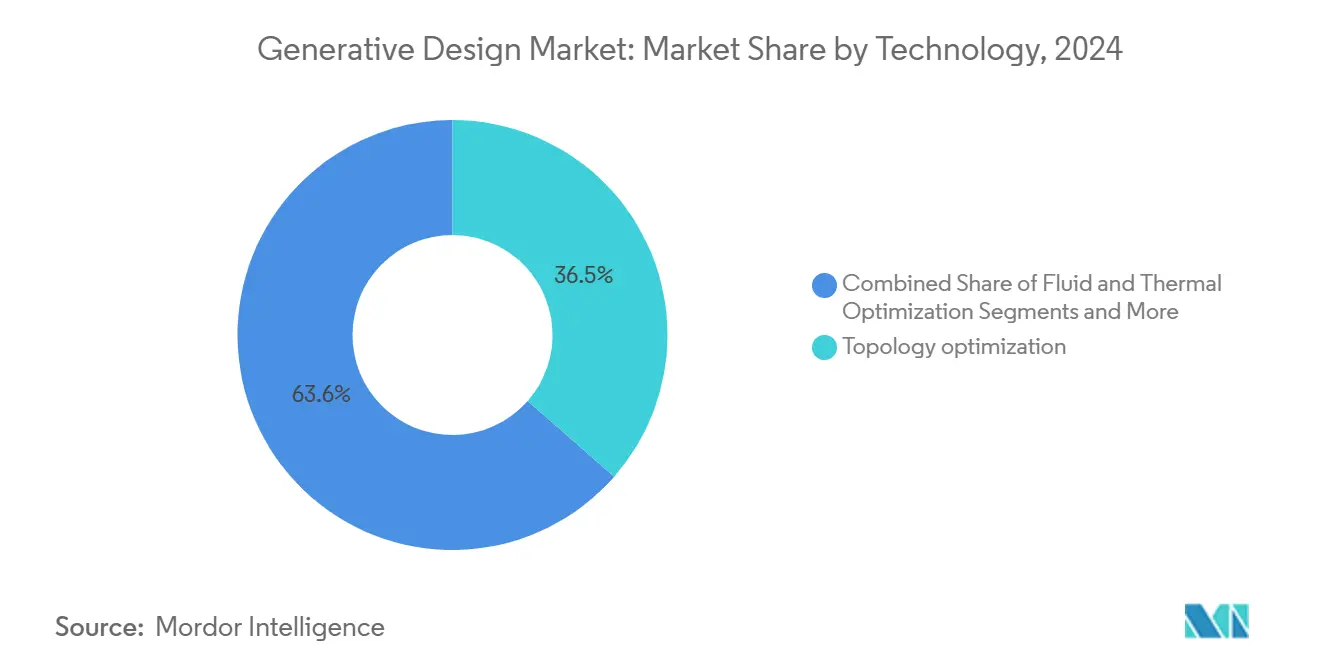
Note: Segment shares of all individual segments available upon report purchase
By End-User Industry: Medical devices lead growth despite automotive dominance
Automotive kept a 28.67% revenue lead in 2024 owing to lightweighting imperatives tied to electric-vehicle range, making it the prime anchor customer for vendors and service integrators. Automakers apply generative routines across seats, body-in-white nodes, and battery enclosures, embedding AI in standardized design cycles. However, medical devices are expanding at a 15.87% CAGR because patient-specific implants and surgical tools derive exceptional value from AI-created lattices and complex organic geometries.
Regulatory clarity from the FDA’s evolving AI guidance diminishes earlier uncertainty, encouraging investment in custom spinal cages and cranial plates that match patient CT scans. High gross margins in orthopedic and cardiovascular equipment, finance, premium software subscriptions, and specialist consulting. Aerospace, industrial machinery, and consumer products follow with steady adoption arcs; each tailors optimization targets to sector norms, fatigue life for aircraft fittings, uptime for factory tooling, and aesthetics for consumer electronics. The diversity of applications underscores that future competitive edge will lie in deep vertical expertise layered atop generic AI platforms.
Geography Analysis
North America controlled 38.50% of 2024 global revenue as early automotive and aerospace pilots matured into enterprise roll-outs, and software headquarters proximity accelerated co-development cycles with customers. R&D tax incentives and robust venture funding supported new entrants that feed innovation into the wider ecosystem. Growth is steady but slower than in emerging regions because many Fortune 500 manufacturers have already finished first-wave deployments and now focus on scaling rather than new licenses.
Asia Pacific is recording the fastest expansion, charting a 16.92% CAGR through 2030 on the back of China’s manufacturing-digitization mandates, Japan’s Society 5.0 roadmap, and South Korea’s semiconductor competitiveness agenda. Local cloud providers team with software firms to localize interfaces and ensure data residency, which accelerates adoption among domestic SMEs that previously balked at foreign-hosted options. Governments set up shared innovation centers, offering subsidized HPC credits that further stimulate generative design uptake.
Europe shows solid mid-single-digit growth tied to stringent sustainability regulations that reward material savings and lifecycle-carbon cuts. Germany’s automotive giants push suppliers to adopt AI-led lightweighting, while Scandinavian builders use generative tools for timber and modular construction. Although macroeconomic uncertainty tempers capital spending in some segments, regulatory pressure keeps projects moving. South America, the Middle East, and Africa trail but build momentum as infrastructure spending and local manufacturing clusters grow; vendors plant regional partnerships to capture early mindshare in these nascent arenas.
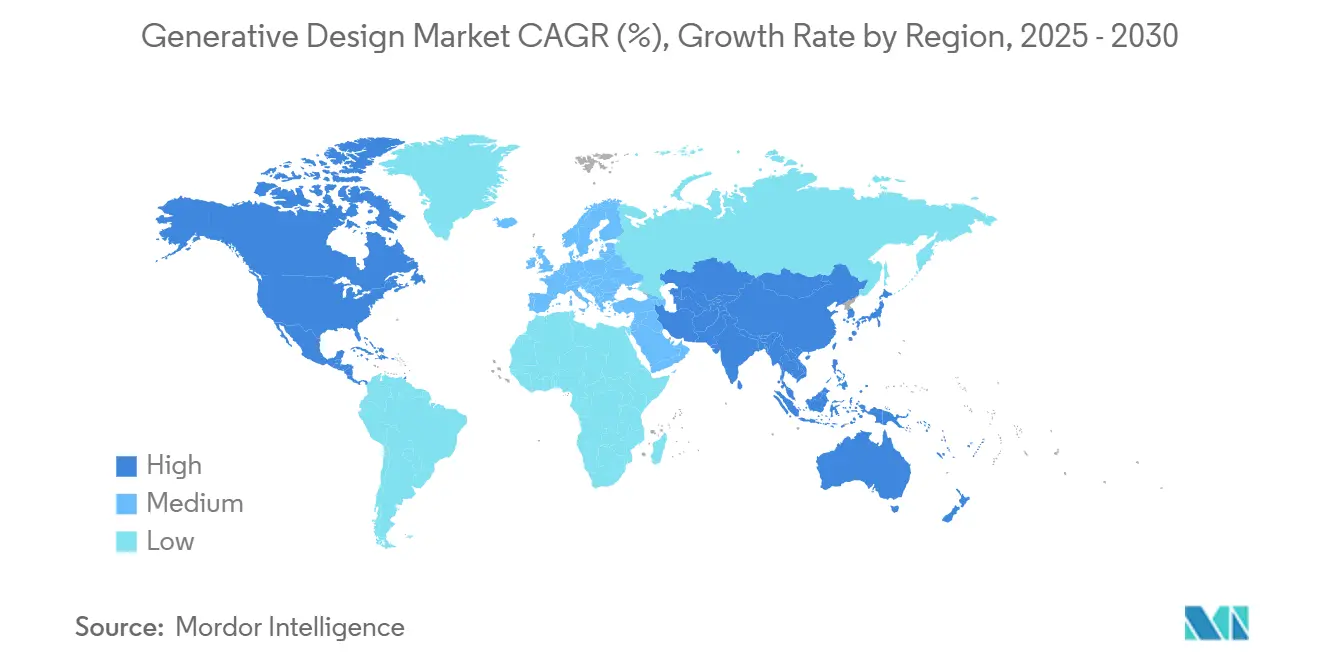
Competitive Landscape
Incumbent CAD/CAE suites, Autodesk, Dassault Systèmes, and Siemens, leverage broad install bases and tight PLM integration to defend share, together accounting for 43% of global revenue in 2024. Their strategy layers AI solvers onto familiar interfaces, minimizing retraining time for users. Siemens’ USD 10.6 billion Altair acquisition illustrates the scale at which leaders are willing to deploy capital to secure best-in-class optimization engines and simulation depth. Synopsys’ USD 35 billion purchase of Ansys underscores a wider consolidation trend, blending semiconductor and mechanical design value chains to form cross-domain solution suites.
AI-native challengers like nTopology and Hyperganic differentiate with cloud-first architectures and open APIs, letting customers script design logic and automate bulk part generation. Spectral Labs pursues a model-as-a-service approach, renting access to pretrained geometry generators that can be fine-tuned for proprietary datasets. Dassault integrates Mistral AI’s language models so engineers can issue natural-language prompts, while Siemens teams with NVIDIA to optimize solver performance on GPU clusters. Patent filings around multi-objective search heuristics and manufacturing-constraint embeddings rise sharply, signaling a move to protect algorithmic moats.
White-space innovation blooms in circular-economy and real-time digital-twin loops, where start-ups craft modules that feed sensor data back into live design optimizations. As customers seek turnkey stacks spanning concept, simulation, and factory execution, market power accrues to vendors that orchestrate heterogeneous tools without locking users into closed formats. Overall, competitive rivalry intensifies, yet fragmentation persists outside the top tier, keeping the generative design market moderately concentrated.
Generative Design Industry Leaders
-
Autodesk Inc.
-
Dassault Systèmes SE
-
Synopsys, Inc.
-
PTC Inc. (Frustum Inc.)
-
Bentley Systems, Inc.
- *Disclaimer: Major Players sorted in no particular order
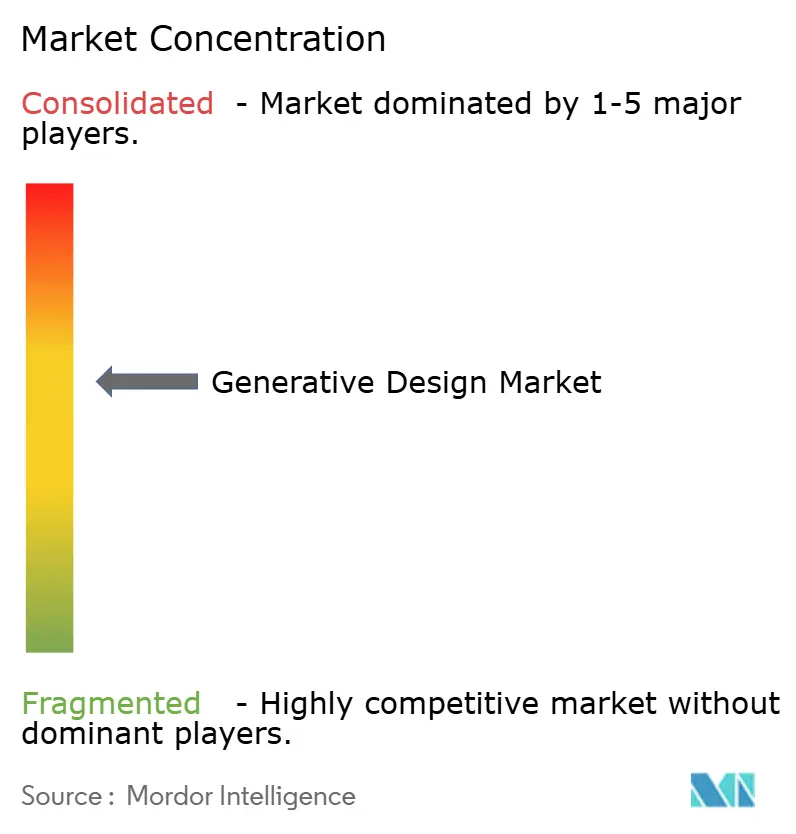
Recent Industry Developments
- July 2025: Synopsys finalized its USD 35 billion purchase of Ansys, linking chip-design automation with generative mechanical solvers.
- March 2025: Siemens completed its USD 10.6 billion acquisition of Altair Engineering, merging PLM depth with advanced optimization workflows.
- October 2024: Bentley Systems released OpenSite+ with generative AI for civil-infrastructure layout and compliance optimization.
- July 2024: Dassault Systèmes entered a strategic partnership with Mistral AI to embed large-language-model interfaces in 3DEXPERIENCE.
- May 2024: Autodesk launched Project Bernini, allowing text-prompt and sketch-driven 3D shape generation.
Global Generative Design Market Report Scope
Engineering software known as generative design automatically develops high-performance design iterations based on performance or space requirements, manufacturing processes, materials, and costs. It uses artificial intelligence (AI) algorithms to create highly customized complicated structures and internal lattices that are impossible to construct using traditional manufacturing techniques.
The Generative Design Market is segmented by Deployment (On-premise, Cloud), End User Vertical (Automotive, Aerospace and Defense, Architecture and Construction, Manufacturing Machinery), and Geography.
The market sizes and forecasts are provided in terms of value (USD million) for all the above segments.
| Software |
| Services |
| On-premise |
| Cloud |
| Topology Optimization |
| Fluid and Thermal Optimization |
| Lattice and Surface Generation |
| AI-driven Multi-objective Optimization |
| Automotive |
| Aerospace and Defense |
| Architecture and Construction |
| Industrial Equipment |
| Consumer Products |
| Medical Devices |
| Energy and Utilities |
| Other End-user Industries |
| North America | United States |
| Canada | |
| Mexico | |
| South America | Brazil |
| Argentina | |
| Rest of South America | |
| Europe | Germany |
| United Kingdom | |
| France | |
| Spain | |
| Italy | |
| Russia | |
| Rest of Europe | |
| Asia Pacific | China |
| Japan | |
| India | |
| South Korea | |
| Rest of Asia Pacific | |
| Middle East | UAE |
| Saudi Arabia | |
| Rest of the Middle East | |
| Africa | South Africa |
| Rest of Africa |
| By Component | Software | |
| Services | ||
| By Deployment | On-premise | |
| Cloud | ||
| By Technology | Topology Optimization | |
| Fluid and Thermal Optimization | ||
| Lattice and Surface Generation | ||
| AI-driven Multi-objective Optimization | ||
| By End-user Industry | Automotive | |
| Aerospace and Defense | ||
| Architecture and Construction | ||
| Industrial Equipment | ||
| Consumer Products | ||
| Medical Devices | ||
| Energy and Utilities | ||
| Other End-user Industries | ||
| By Geography | North America | United States |
| Canada | ||
| Mexico | ||
| South America | Brazil | |
| Argentina | ||
| Rest of South America | ||
| Europe | Germany | |
| United Kingdom | ||
| France | ||
| Spain | ||
| Italy | ||
| Russia | ||
| Rest of Europe | ||
| Asia Pacific | China | |
| Japan | ||
| India | ||
| South Korea | ||
| Rest of Asia Pacific | ||
| Middle East | UAE | |
| Saudi Arabia | ||
| Rest of the Middle East | ||
| Africa | South Africa | |
| Rest of Africa | ||
Key Questions Answered in the Report
How large is the generative design market in 2025?
It is valued at USD 4.30 billion in 2025 and is projected to grow at a 14.82% CAGR through 2030.
Which component grows faster—software or services?
Services expand more quickly at a 15.12% CAGR because firms need integration expertise, while software retains the larger revenue base.
Why is Asia Pacific the fastest-growing region?
Government digitization plans, subsidized cloud HPC, and the region’s manufacturing density combine to drive a 16.92% CAGR.
What technology segment is rising the quickest?
AI-driven multi-objective optimization leads with a 16.34% CAGR as companies seek holistic constraint balancing.
How do sustainability mandates influence adoption?
Carbon-reduction regulations force designers to treat material efficiency as a primary constraint, making generative design a preferred solution.
Who are the leading vendors?
Autodesk, Dassault Systèmes, and Siemens together hold about 43% of global revenue, with AI-native firms like nTopology growing rapidly.
Page last updated on:
